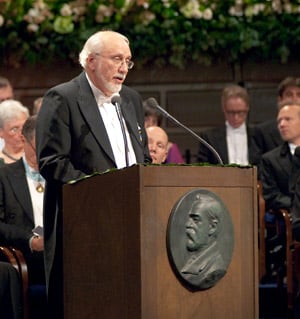Award ceremony speech
Presentation Speech by Professor Joseph Nordgren, Member of the Royal Swedish Academy of Sciences, Chairman of the Nobel Committee for Physics, 10 December 2009
 |
| Professor Joseph Nordgren delivering the Presentation Speech for the 2009 Nobel Prize in Physics at the Stockholm Concert Hall. Copyright © The Nobel Foundation 2009 Photo: Hans Mehlin |
Your Majesties, Your Royal Highnesses, Ladies and Gentlemen,
This year’s Nobel Prize in Physics rewards work that has had a decisive impact both on our daily lives and on scientific progress. Today we take it for granted that at any time, we can phone someone on the other side of the globe and have a conversation while enjoying the same sound quality as if we were talking to someone in the same room. Likewise, we take it for granted that we can view photos and video reports of events on other continents at the same instant as they unfold. Our computers are linked up to the world-wide Internet, which has become an almost indispensable element of modern society. It provides efficient communication channels between people and quick access to the information we need at the moment.
Various forms of optical communication were used in the past to send information across long distances. Chains of beacons signalled approaching misfortune, and the optical telegraph could be used for more complex messages. But these forms of optical communication quickly became obsolete as electrical communication in the form of telegraphy, telephony and radio were developed.
Optical communication has made a comeback as a superior communication channel. Light has many thousands of times greater capacity to convey information than copper cables and radio waves. This is related to the fact that the frequency of light waves is much higher than that of electrical waves, enabling the transmission of much faster variations in the signal. Early in the second half of the 20th century, researchers tried to utilise this advantage by transmitting light in optical fibers across long distances, but they encountered great difficulties because attenuation in the fiber was so great that practically all the light had faded away after a few hundred metres. It was not until after Charles Kao showed the way in 1966 towards successful transmission using ultra-pure glass fibers that this new communication technology made its breakthrough. Only four years later, the optical fibers that Kao predicted had become possible, and today his vision of a future communication-based society has become a reality.
Video technology and digital photography play a very prominent role in our daily lives, thanks to television and digital cameras. In science and technology, such tools are irreplaceable today. A large proportion of the information flowing through the global fiber-based Internet consists of images and video material in digital form. One technology that has been of crucial importance in making this possible originated from an invention made in 1969 by Willard Boyle and George Smith. They designed an electronic circuit that can store and read out information about how electrical charges are distributed across its surface − electrical charges that together form an image. The charge-coupled device, or CCD, was born.
Through its simple structure and ingenious function, the CCD enables very efficient and sensitive recording, storage and read-out of high-resolution images in electronic form. As an image sensor, the CCD usually serves as the electronic eye of advanced digital cameras and TV cameras. It is also a very central component of many scientific and medical devices, for example astronomical telescopes and instruments used for “key-hole” surgery.
Dr Kao, Dr Boyle, Dr Smith:
You have been awarded the 2009 Nobel Prize in Physics for your ground-breaking contributions to optical communication and image recording. On behalf of the Royal Swedish Academy of Sciences, it is my privilege and pleasure to convey to you the warmest congratulations for your outstanding work. I now ask you to step forward to receive your Nobel Prizes from the hands of His Majesty the King.
Nobel Prizes and laureates
Six prizes were awarded for achievements that have conferred the greatest benefit to humankind. The 14 laureates' work and discoveries range from quantum tunnelling to promoting democratic rights.
See them all presented here.
